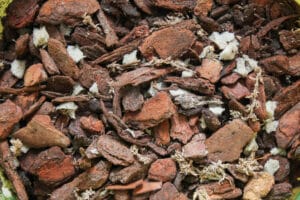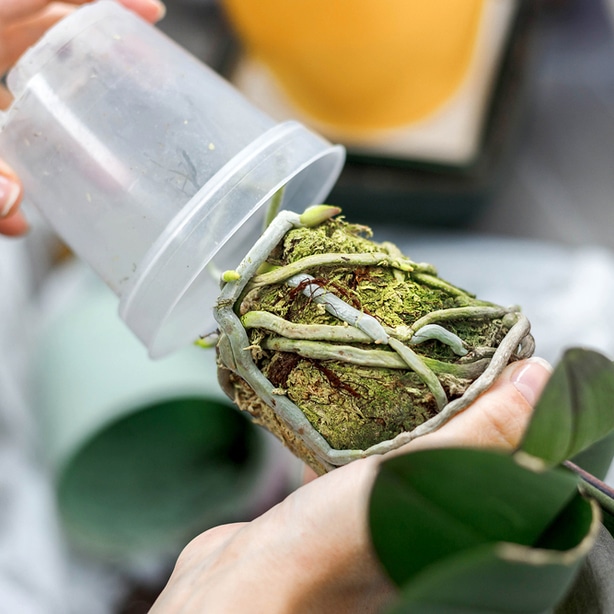Exotic and stately, with deceptively delicate petals and sepals, the Phalaenopsis orchid is a favorite among hobbyists and professionals. Known for its forgiving nature, this exquisite perennial plant is often associated with tropical climates, although it can be easily nurtured in virtually any environment.
The secret to successfully raising these floral beauties is twofold: carefully balance the orchid’s cultural needs and listen to it. Phals tell us what they need to bloom big, bold, and beautiful. To successfully care for them, we need only pay attention.
Make sure to check out our other orchid guides as well. For instance, we have a guide on raising healthy cymbidiums.
More than 30,000 orchid species have been identified. The Phalaenopsis (pronounced fal-uh-NOP-sis) is a show-stopper. Its impressive flowers are brilliant. Each flower spike supports cascading arches that are graceful and elegant.
This orchid is a popular centerpiece at events. It is known for its understated yet stunning displays of color. This Asian native is also a good choice for home and office decorating.
The flower was originally named Epidendrum amabile in the mid-1700s by a Swedish botanist and zoologist. Legend has it that around that same time, a Swedish naturalist exploring in a tropical jungle mistakenly thought a cluster of Phals was an eclipse of moths. From then forward, these light-lovers were fondly known as the moth orchid. In Greek, phal means moth and opsis means appearance. Around 1825, a German-Dutch naturalist renamed the species Phalaenopsis amabilis, a moniker that has stood the test of time.

General Care
New orchid owners would do well to plant their hopes on the Phalaenopsis. At first glance, the single flower stake and butterfly-shaped petals appear fragile. Make no mistake, though, this flower is remarkably resilient and may even offer hints to signal what it needs to flourish.
Caregivers should consider five environmental factors to ensure exquisiteness: light, water, fertilization, humidity, and temperature. These factors must work in harmony for your colorful sprays to thrive. Adjusting one of the variables will require adjustments in all the others. Let us consider each factor in turn.
Light
These orchids prefer brightly lit east windows streaming indirect light. They do not care for harsh, hot, and direct light. For those in natural light-challenged environments, it is possible to grow these plants inside with the use of indoor grow lights.
Watch your plant’s leaves to know if the light is spot on. According to the American Orchid Society, you can spot a healthy Phal by the color of its leaves: look for olive green. Darker leaves suggest more light is needed. Tinges of red signal too much light.
One more point about light. Once in bloom, its tolerance for direct sunlight decreases even further.

Water
Place your potted plant in a sink and allow the water to gently flow around the flower stake and into the potting medium. How often you will need to water your orchid will depend on the medium you use. For instance, moss retains more water than moss. A good rule of thumb is to water mature plants weekly. If you are using moss, you will want to feel your moss and only water when the top couple bunches of moss feel dry.
How frequently you water will also depend on the amount of light and heat your orchid is receiving. If there are more of either of these, then you will likely need to water more frequently.
If you can, try to water in the morning. This will allow the plant’s leaves to dry from the heat of the sun. It is also good practice to carefully dry your plant’s flowers and leaves after watering.
To avoid root rot, never allow your plants to stand directly in water. Instead, put them on a bed of rocks that are resting in fresh water.

Fertilization
Phals growing in a bark-based potting medium appreciate a high-nitrogen fertilizer. Adjust the amount of nitrogen to support other potting media. To induce flowering, opt for a formula that is phosphorus-rich. Depending on the other environmental factors, expect to fertilize twice a month.
Humidity
Regulating humidity is important because it helps to ensure your plant stays hydrated. You can use a shallow tray of pebbles filled with water to help increase the humidity around your plants. If you do this, just make sure that the pot doesn’t sit in the water. This will cause the medium to wick up the water and will cause root rot.
Related to this environmental factor is proper airflow. This is an important consideration because it helps to dry excess moisture that may be clinging to your orchid’s leaves. Watch for condensation on your plant’s leaves. Any moisture should be carefully dried with a clean cloth.

Temperature
If you are comfortable, it is likely that your phalaenopsis is too. During the day, aim for temperatures that span from 70 degrees Fahrenheit to 80 degrees Fahrenheit. That said, your potted beauty can withstand temperatures up to 95 degrees Fahrenheit. At night, these orchids enjoy a cool 60 degrees. Higher temperatures force expedited growth.
Remember, though, that these variables must be balanced. As the temperature increases, humidity and air movement will need careful monitoring. Are you noticing buds that are ready to open but drop instead? This is your plant subtly telling you that it needs more stable temperatures.
Potting and Medium
Phals must be planted in a porous mixture that easily drains water. Coarse bark is a good choice.

Seedlings will likely outgrow their pots in about 12 months. More mature plants can enjoy the same base for up to three years. The optimal time to repot your orchid is just past its peak when the blooms have withered.
To transplant your tropical specimens, carefully shake loose the old medium from the roots. Assess the health of the root structure. Remove soft, weakened, or rotted areas.

Root System
Phals have air roots. Healthy air roots are solid and white. Sometimes these roots may break through the surface of the potting medium. The roots will also be covered with a spongy, skin-like tissue that absorbs water and nutrients, including nitrogen.
Air roots that have become yellow and shriveled are unhealthy. These should be snipped.
Once the trimming is complete, separate the remaining healthy root strands. Surround each with potting medium. Finally, fill the pot to the base of the flower stake.

Propagation
Commercial growers reproduce phalaenopsis orchids from seeds or through tissue culture. This is a tricky business and best left to professionals.
Home growers are more successful transplanting offshoots, which are called both plantlets and keikies. This new life sprouts from nodes found on the flower stake.
Growers can encourage the growth of keikies with a keiki paste growth hormone found at garden shops. Using a sterilized instrument, break through the surface of a bud forming at a node. Coat the bud with the hormone and wait.
Watch for the keikies to sprout roots that are several inches long. At this point, the offshoot can be trimmed from the mother plant and potted as a seedling.

Varieties
The 2010 edition of the World Checklist of Monocotyledons documents more than 60 species of the Phalaenopsis, even more subspecies, and seven natural hybrids. These varieties are distinguishable in many ways, including the following:
- color and shape of their leaves
- number and shape of their sepals and petals
- shape of the flower’s lip
- size of the flower stake
- number and color of flowers
- root structure
Like so many orchids, Phals are also known for their dramatic encores. Phalaenopsis frequently bloom more than once a year. After taking a break – that can last from six to nine months – these dazzling orchids are born again. Tapping stored energy, these encore blooms color your room with a page from nature.

